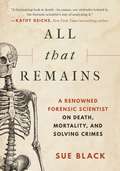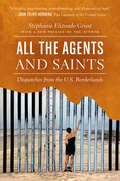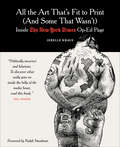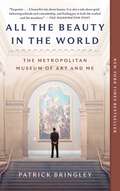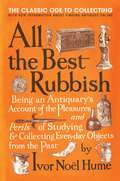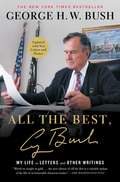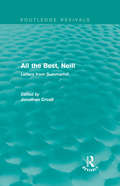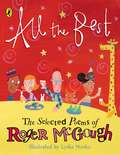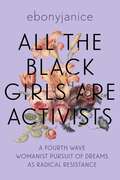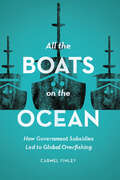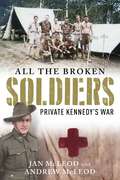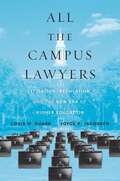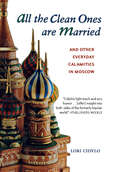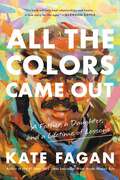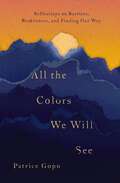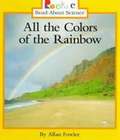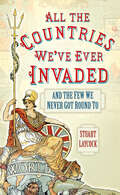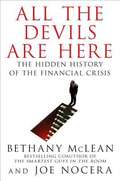- Table View
- List View
All that Remains: A Renowned Forensic Scientist on Death, Mortality, and Solving Crimes
by Sue BlackBook of the Year, 2018 Saltire Literary Awards For fans of Caitlin Doughty, Mary Roach, and CSI shows, a renowned forensic scientist on death and mortality. Dame Sue Black is an internationally renowned forensic anthropologist and human anatomist. She has lived her life eye to eye with the Grim Reaper, and she writes vividly about it in this book, which is part primer on the basics of identifying human remains, part frank memoir of a woman whose first paying job as a schoolgirl was to apprentice in a butcher shop, and part no-nonsense but deeply humane introduction to the reality of death in our lives. It is a treat for CSI junkies, murder mystery and thriller readers, and anyone seeking a clear-eyed guide to a subject that touches us all. Cutting through hype, romanticism, and cliché, she recounts her first dissection; her own first acquaintance with a loved one’s death; the mortal remains in her lab and at burial sites as well as scenes of violence, murder, and criminal dismemberment; and about investigating mass fatalities due to war, accident, or natural disaster, such as the 2004 Indian Ocean tsunami. She uses key cases to reveal how forensic science has developed and what her work has taught her about human nature. Acclaimed by bestselling crime writers and fellow scientists alike, All That Remains is neither sad nor macabre. While Professor Black tells of tragedy, she also infuses her stories with a wicked sense of humor and much common sense.
All the Agents and Saints, Paperback Edition: Dispatches from the U.S. Borderlands
by Stephanie Elizondo GriestAfter a decade of chasing stories around the globe, intrepid travel writer Stephanie Elizondo Griest followed the magnetic pull home—only to discover that her native South Texas had been radically transformed in her absence. Ravaged by drug wars and barricaded by an eighteen-foot steel wall, her ancestral land had become the nation's foremost crossing ground for undocumented workers, many of whom perished along the way. The frequency of these tragedies seemed like a terrible coincidence until Elizondo Griest moved to the New York–Canada borderlands. Once she began to meet Mohawks from the Akwesasne Nation, she recognized striking parallels to life on the southern border. Having lost their land through devious treaties, their mother tongues at English-only schools, and their traditional occupations through capitalist ventures, Tejanos and Mohawks alike struggle under the legacy of colonialism. Toxic industries surround their neighborhoods, while the U.S. Border Patrol militarizes them. Combating these forces are legions of artists and activists devoted to preserving their indigenous cultures. Complex belief systems, meanwhile, conjure miracles. In All the Agents and Saints, Elizondo Griest weaves seven years of stories into a meditation on the existential impact of international borderlines by illuminating the spaces in between and the people who live there. This edition features a new preface by the author.
All the Art That's Fit to Print (And Some That Wasn't): Inside The New York Times Op-Ed Page
by Jerelle KrausAll the Art That's Fit to Print reveals the true story of the world's first Op-Ed page, a public platform that—in 1970—prefigured the Internet blogosphere. Not only did the New York Times's nonstaff bylines shatter tradition, but the pictures were revolutionary. Unlike anything ever seen in a newspaper, Op-Ed art became a globally influential idiom that reached beyond narrative for metaphor and changed illustration's very purpose and potential. Jerelle Kraus, whose thirteen-year tenure as Op-Ed art director far exceeds that of any other art director or editor, unveils a riveting account of working at the Times. <P><P>Her insider anecdotes include the reasons why artist Saul Steinberg hated the Times, why editor Howell Raines stopped the presses to kill a feature by Doonesbury's Garry Trudeau, and why reporter Syd Schanburg-whose story was told in the movie The Killing Fields-stated that he would travel anywhere to see Kissinger hanged, as well as Kraus's tale of surviving two and a half hours alone with the dethroned peerless outlaw, Richard Nixon.All the Art features a satiric portrayal of John McCain, a classic cartoon of Barack Obama by Jules Feiffer, and a drawing of Hillary Clinton and Obama by Barry Blitt. But when Frank Rich wrote a column discussing Hillary Clinton exclusively, the Times refused to allow Blitt to portray her. Nearly any notion is palatable in prose, yet editors perceive pictures as a far greater threat. Confucius underestimated the number of words an image is worth; the thousand-fold power of a picture is also its curse.Op-Ed's subject is the world, and its illustrations are created by the world's finest graphic artists. The 142 artists whose work appears in this book hail from thirty nations and five continents, and their 324 pictures-gleaned from a total of 30,000-reflect artists' common drive to communicate their creative visions and to stir our vibrant cultural-political pot.
All the Art That's Fit to Print (And Some That Wasn't): Inside The New York Times Op-Ed Page
by Jerelle KrausFrom the New York Times&’s former Op-Ed art director, the true story of the world&’s first Op-Ed page, a public platform that prefigured the blogosphere. Jerelle Kraus, whose thirteen-year tenure as Op-Ed art director far exceeds that of any other art director or editor, unveils a riveting account of working at the Times. Her insider anecdotes include the reasons why artist Saul Steinberg hated the Times, why editor Howell Raines stopped the presses to kill a feature by Doonesbury&’s Garry Trudeau, and why reporter Syd Schanburg—whose story was told in the movie The Killing Fields—stated that he would travel anywhere to see Kissinger hanged, as well as Kraus&’s tale of surviving two and a half hours alone with the dethroned outlaw, Richard Nixon. All the Art features a satiric portrayal of John McCain, a classic cartoon of Barack Obama by Jules Feiffer, and a drawing of Hillary Clinton and Obama by Barry Blitt. But when Frank Rich wrote a column discussing Hillary Clinton exclusively, the Times refused to allow Blitt to portray her. Nearly any notion is palatable in prose, yet editors perceive pictures as a far greater threat. Confucius underestimated the number of words an image is worth; the thousand-fold power of a picture is also its curse . . . Features 142 artists from thirty nations and five continents, and 324 pictures—gleaned from a total of 30,000—that stir our cultural-political pot. &“To discover what really goes on inside the belly of the media beast, read this book.&” —Bill Maher &“In this overflowing treasure chest of ideas, politics and cultural critiques, Kraus proves that &“art is dangerous&” and sometimes necessarily so.&” —Publishers Weekly
All the Beauty in the World: The Metropolitan Museum of Art and Me
by Patrick BringleyNew York Times bestseller Named one of the best books of the year by the New York Public Library, the Financial Times, the New York Post, Book Riot, and The Sunday Times (London). An &“exquisite&” (The Washington Post) &“hauntingly beautiful&” (Associated Press) portrait of the Metropolitan Museum of Art and its treasures by a former New Yorker staffer who spent a decade as a museum guard.Millions of people climb the grand marble staircase to visit the Metropolitan Museum of Art every year. But only a select few have unrestricted access to every nook and cranny. They&’re the guards who roam unobtrusively in dark blue suits, keeping a watchful eye on the two million square foot treasure house. Caught up in his glamourous fledgling career at The New Yorker, Patrick Bringley never thought that he&’d be one of them. Then his older brother was diagnosed with fatal cancer and he found himself needing to escape the mundane clamor of daily life. So he quit The New Yorker and sought solace in the most beautiful place he knew. To his surprise and your delight, this temporary refuge becomes Bringley&’s home away from home for a decade. We follow him as he guards delicate treasures from Egypt to Rome, strolls the labyrinths beneath the galleries, wears out nine pairs of company shoes, and marvels at the beautiful works in his care. Bringley enters the museum as a ghost, silent and almost invisible, but soon finds his voice and his tribe: the artworks and their creators and the lively subculture of museum guards—a gorgeous mosaic of artists, musicians, blue-collar stalwarts, immigrants, cutups, and dreamers. As his bonds with his colleagues and the art grow, he comes to understand how fortunate he is to be walled off in this little world, and how much it resembles the best aspects of the larger world to which he gradually, gratefully returns. In the tradition of classic workplace memoirs like Lab Girl and Working Stiff, All the Beauty in the World is an &“empathic&” (The New York Times Book Review), &“moving&” (NPR), &“consoling, and beautiful&” (The Guardian) portrait of a great museum, its hidden treasures, and the people who make it tick, by one of its most intimate observers.
All the Best Rubbish
by Ivor Noël HumeOne person's trash is another's treasure! In his newly revised classic, All the Best Rubbish, Ivor NoËl Hume traces the fascinating history of collecting from its recorded beginnings and describes the remarkable detective work that goes into establishing the probable facts about uncovered and often underappreciated treasures. Now expanded with hints, tips, and helpful information about antique-hunting online, All the Best Rubbish is the ideal book for the antiquarian or amateur, the historian or professional collector--for anyone who knows that there's no such thing as "just junk."
All the Best, George Bush: My Life in Letters and Other Writings
by George H.W. BushFormer President George H.W. Bush, revealed through his letters and writings from 1941 to 2010, is "worth its weight in gold...a valuable update of the life of an honorable American leader" (The Washington Post)."Who knew that beneath George Bush's buttoned-up propriety pulsed the warm heart of a prolific and occasionally poetic writer with a wacky sense of humor?" (People) Though reticent in public, George Bush openly shared his private thoughts in correspondence throughout his life. This collection of letters, diary entries, and memos is the closest we'll ever get to his autobiography.Organized chronologically, readers will gain insights into Bush's career highlights--the oil business, his two terms in Congress, his ambassadorship to the UN, his service as an envoy to China, his tenure with the Central Intelligence Agency, and of course, the vice presidency, the presidency, and the post-presidency. They will also observe a devoted husband, father, and American. Ranging from a love letter to Barbara and a letter to his mother about missing his daughter, Robin, after her death from leukemia to a letter to his children written just before the beginning of Desert Storm, this collection is remarkable for Bush's candor, humor, and poignancy. "An unusual glimpse of the private thoughts of a public figure" (Newsweek), this revised edition includes new letters and photographs that highlight the Bush family's enduring legacy, including letters that cover George W. Bush's presidency, 9/11, Bush senior's work with President Clinton to help the victims of natural disasters, and the meaning of friendship and family. All the Best, George Bush "will shed more light on the man's personal character and public persona than any memoir or biography could" (Publishers Weekly).
All the Best, Neill: Letters from Summerhill (Routledge Revivals)
by Jonathan CroallA. S. Neill, founder of Summerhill, the most admired and most feared of all progressive schools, was famous as a schoolteacher, educational reformer, and author of illuminating and stylish books about education and the mind of the child. But few people know he was also a dedicated, prolific, uninhibited, witty and often mischievous letter writer. This selection of gems, first published in 1983, has been chosen from hundreds of his letters by his biographer. It includes letters about education, children, politics, writing, fatherhood, the Bomb, old age and death. ‘All the best, Neill’ was the familiar ending of his letters to the famous – H. G. Wells, Bertrand Russell, Henry Miller, Paul Goodman, Wilhelm Reich, Homer Lane; to important educators – W. B. Curry of Dartington, John Aitkenhead of Kilquhanity, Bob Mackenzie of Braehead, Dora Russell of Beacon Hill; to unknown friends, parents, and even casual correspondents. To read these letters is to share the company of a great and always delightful man, who wrote each one with the same commitment and gaiety.
All the Best: The Selected Poems of Roger McGough
by Roger McGoughA wonderful selection of over 100 of Roger's own best-loved poems from his vast Puffin catalogue of poetry collections. Lots of favourites and some lesser known surprises, too. Packed with fabulous Lydia Monks illustrations throughout.
All the Black Girls Are Activists
by EbonyJanice Moore&“Who would black women get to be if we did not have to create from a place of resistance?&”Hip Hop Womanist writer and theologian EbonyJanice&’s book of essays center a fourth wave of Womanism, dreaming, the pursuit of softness, ancestral reverence, and radical wholeness as tools of liberation. All The Black Girls Are Activists is a love letter to Black girls and Black women, asking and attempting to offer some answers to &“Who would black women get to be if we did not have to create from a place of resistance?&” by naming Black women&’s wellness, wholeness, and survival as the radical revolution we have been waiting for. About the Author: EbonyJanice is a dynamic lecturer, transformational speaker, passionate multi-faith preacher, and creative focused on Decolonizing Authority, Hip Hop Scholarship, Womanism as a Political and Spiritual/Religious tool for Liberation, Blackness as Religion, Dialogue as central to professional development and personal growth, and Women and Gender Studies focused on black girlhood. EbonyJanice holds a B.A. in Cultural Anthropology and Political Science and a Master of Arts in Social Change with a concentration in Spiritual Leadership, Womanist Theology, and Racial Justice. She is the founder of Black Girl Mixtape, a multi-platform safe think-space centering the intellectual and creative authority of black women in the form of a lecture series, an online learning institute, and a creative collaborative. EbonyJanice is also the founder of Dream Yourself Free, a Spiritual Mentoring project focused on black women's healing, dreaming, ease, play, and wholeness as their activism and resistance work.
All the Boats on the Ocean: How Government Subsidies Led to Global Overfishing
by Carmel FinleyMost current fishing practices are neither economically nor biologically sustainable. Every year, the world spends $80 billion buying fish that cost $105 billion to catch, even as heavy fishing places growing pressure on stocks that are already struggling with warmer, more acidic oceans. How have we developed an industry that is so wasteful, and why has it been so difficult to alter the trajectory toward species extinction? In this transnational, interdisciplinary history, Carmel Finley answers these questions and more as she explores how government subsidies propelled the expansion of fishing from a coastal, in-shore activity into a global industry. While nation states struggling for ocean supremacy have long used fishing as an imperial strategy, the Cold War brought a new emphasis: fishing became a means for nations to make distinct territorial claims. A network of trade policies and tariffs allowed cod from Iceland and tuna canned in Japan into the American market, destabilizing fisheries in New England and Southern California. With the subsequent establishment of tuna canneries in American Samoa and Puerto Rico, Japanese and American tuna boats moved from the Pacific into the Atlantic and Indian Oceans after bluefin. At the same time, government subsidies in nations such as Spain and the Soviet Union fueled fishery expansion on an industrial scale, with the Soviet fleet utterly depleting the stock of rosefish (or Pacific ocean perch) and other groundfish from British Columbia to California. This massive global explosion in fishing power led nations to expand their territorial limits in the 1970s, forever changing the seas. Looking across politics, economics, and biology, All the Boats on the Ocean casts a wide net to reveal how the subsidy-driven expansion of fisheries in the Pacific during the Cold War led to the growth of fisheries science and the creation of international fisheries management. Nevertheless, the seas are far from calm: in a world where this technologically advanced industry has enabled nations to colonize the oceans, fish literally have no place left to hide, and the future of the seas and their fish stocks is uncertain.
All the Brains in the Business: The Engendered Brain in the 21st Century Organisation (The Neuroscience of Business)
by Paul Brown Kate LanzThe power of gender difference, not gender equality, is a secret source for success. Some smart businesses are starting to wake up to this fact. This book explores why and how. Properly valuing brain gender diversity in the workplace is one of the biggest and largely untapped sources of competitive advantage for modern businesses. Recent advances in neuroscience provide the key to unlocking it. Modern research shows that there are gender-based differences in the brain – it’s just not as simple as a binary between a ‘male brain’ and ‘female brain’. In fact, our brains are like a mosaic where many of the tiles are available in thousands of shades on a spectrum between pink and blue. The problem is that our workplaces tend to be governed by structures, processes and cultures that are practically pure blue. All the brains in the business that are elsewhere on the spectrum cannot thrive as they might, so sources of productivity, creativity and agility go untapped. Anyone who manages people needs to understand how the brain works and the impact it has on how people work together as teams. Anyone who wants to unlock the talent and productivity of all of their people needs to understand how recent findings around male- and female-type brains should shape the way they manage. Leading applied neuroscientists and international corporate coaches Kate Lanz and Paul Brown show you why and how to access all the brains in your business.
All the Broken Soldiers: Private Kennedy's War
by Dr Jan McLeod Dr Andrew McLeodThis is the story of a soldier without a gun. It is personal, yet universal. It is the story of what is left behind when the battles have been fought and the war has moved on.To the Australian Army, Private Lawrence Nicholas Kennedy was NX21854, a soldier who served for 1907 days with the 2/4th Australian Army Field Ambulance in Australia, the Middle East, the Kokoda Track and New Guinea during World War II. With older brother, Bill by his side, the Kennedy boys experienced the adventure and the joy, the loss and the despair of war – like too many others before and since. To those who knew Nick Kennedy after the war, he was a dedicated and professional psychiatric nurse. To the author, he was her gentle Uncle Nick, remembered as a kind, funny and generous man who seemed older than his years. The small diary he kept during World War II helped her understand why that was so. Kennedy&’s words and photographs tell the harrowing and compelling story of one young man who went to war – not to kill the enemy, but to save his fellow soldiers – only to return home forever changed by the challenges, hardships and tragedy he experienced. All the Broken Soldiers provides a rare insight into an aspect of war fought by soldiers equipped with little more than a basic medical kit and a Red Cross armband … those who cared for the broken soldiers that war leaves behind.
All the Campus Lawyers: Litigation, Regulation, and the New Era of Higher Education
by Joyce P. Jacobsen Louis H. GuardHow colleges and universities can respond to legal pressures while remaining true to their educational missions.Not so long ago, colleges and universities had little interaction with the law. In the 1970s, only a few well-heeled universities even employed in-house legal counsel. But now we live in the age of tenure-denial lawsuits, free speech battles, and campus sexual assault investigations. Even athletics rules violations have become a serious legal matter. The pressures of regulation, litigation, and legislation, Louis Guard and Joyce Jacobsen write, have fostered a new era in higher education, and institutions must know how to respond.For many higher education observers and participants, including most administrators and faculty, the maze of legal mandates and potential risks can seem bewildering. Guard, a general counsel with years of higher education law experience, and Jacobsen, a former college president, map this unfamiliar terrain. All the Campus Lawyers provides a vital, up-to-date assessment of the impact of legal concerns on higher education and helps readers make sense of the most pressing trends and issues, including civil rights; free speech and expression; student life and wellness; admissions, advancement, and community relations; governance and oversight; the higher education business model; and on-campus crises, from cyberattacks to pandemics.As well as informing about the latest legal and regulatory developments affecting higher education, Guard and Jacobsen offer practical guidance to those in positions of campus authority. There has never been a more crucial time for college and university boards, presidents, inside and outside counsel, and other higher education leaders to know the law and prepare for legal challenges.
All the Centurions: The Real "Prince of the City" Tells His Story
by Robert LeuciThe bestselling book and acclaimed film Prince of the City told only part of Robert Leuci's story. In All the Centurions, he shares the full account of his years as a narcotics detective with the New York Police Department -- a tale of daring adventure, shattered illusions, and finally, astonishing spiritual growth.Leuci reminisces about cops both celebrated and notorious, like Frank Serpico, Sonny Grosso, and Frank King from the French Connection case. Also here are politicians, Mafia figures, corrupt defense lawyers, and district attorneys, including a young Rudolph Giuliani. Leuci reveals the dark side of the criminal justice system: the bitterness, greed, cruelty, and ambition that eventually overflowed into the streets, precinct houses, and courtrooms of the city.As vivid and entertaining as the best crime novels, All the Centurions is the story of a man descending into a hell of his own making who ultimately finds his way out through truth and justice.
All the Clean Ones Are Married: And Other Everyday Calamities
by Lori CidyloIn 1991, Lori Cidylo shocked her Ukrainian Polish-born parents when she told them she was leaving her reporter's job on an upstate New York newspaper to live and work in the rapidly dissolving Soviet Union.For six years she lived on a shoe-string budget in Moscow, in tiny, run-down apartments, struggling with broken toilets and indifferent landlords and coping with the daily calamities of life in Russia. Fluent in Russian, she rode on public transportation, did her own shopping and cooking, and shared the typical Muscovite's life––unlike most Westerners who were still sequestered in the heavily guarded compounds reserved for diplomats and journalists. As the country experienced its most dramatic transformation since the Bolshevik Revolution, she realized she had stepped into a fantastical and absurd adventure.Cidylo's wry, insightful account of what it is like for an American woman living in Russia is a dramatic tale full of insouciant laughter, in which the immediate sense of vivid experience shines on every page. With the sharp eye of an acute observer, she captures the momentous events no less than the everyday trivia: how do Russians address one another now that the familiar "comrade" is passé; or how do you find your way home in a city where the streets keep getting new names? As Russia even now continues to struggle with the Cold War's aftermath, Cidylo gives a delightful, surprising, warmly human view of post-Soviet life.
All the Colors Came Out: A Father, a Daughter, and a Lifetime of Lessons
by Kate Fagan"A love story for the ages" from # 1 New York Times bestselling author Kate Fagan comes an unforgettable story about basketball and the enduring bonds between a father and daughter that "will heal relationships and hearts." (Glennon Doyle)Kate Fagan and her father forged their relationship on the basketball court, bonded by sweaty high fives and a dedication to the New York Knicks. But as Kate got older, her love of the sport and her closeness with her father grew complicated. The formerly inseparable pair drifted apart. The lessons that her father instilled in her about the game, and all her memories of sharing the court with him over the years, were a distant memory.When Chris Fagan was diagnosed with ALS, Kate decided that something had to change. Leaving a high-profile job at ESPN to be closer to her mother and father and take part in his care, Kate Fagan spent the last year of her father&’s life determined to return to him the kind of joy they once shared on the court. All the Colors Came Out is Kate Fagan&’s completely original reflection on the very specific bond that one father and daughter shared, forged in the love of a sport which over time came to mean so much more.Studded with unforgettable scenes of humor, pain and hope, Kate Fagan has written a book that plumbs the mysteries of the unique gifts fathers gives daughters, ones that resonate across time and circumstance.
All the Colors We Are/Todos los colores de nuestra piel
by Katie KissingerThe essential resource for 20 years!Celebrate the essence of one way we are all special and different from one another-our skin color! This bilingual (English/Spanish) book offers children a simple, scientifically accurate explanation about how our skin color is determined by our ancestors, the sun, and melanin. It's also filled with colorful photographs that capture the beautiful variety of skin tones. Reading this book frees children from the myths and stereotypes associated with skin color and helps them build positive identities as they accept, understand, and value our rich and diverse world. Unique activity ideas are included to help you extend the conversation with children.Katie Kissinger, MA, is an author, activist, educator for social justice, and an early childhood education college instructor. She is founder and a board member of Threads of Justice Collective, an informal group of educators who work together to promote social and cultural justice for all children and families. Katie lives near Portland, Oregon.Chris Bohnhoff earned a degree in English from Carleton College and then attended the Rocky Mountain School of Photography. Chris takes pictures in his hometown of Minneapolis, Minnesota, and beyond.
All the Colors We Will See: Reflections on Barriers, Brokenness, and Finding Our Way
by Patrice GopoPatrice Gopo grew up in Anchorage, Alaska, the child of Jamaican immigrants who had little experience being black in America. From her white Sunday school classes as a child, to her early days of marriage in South Africa, to a new home in the American South with a husband from another land, Patrice’s life is a testament to the challenges and beauty of the world we each live in, a world in which cultures overlap every day.In All the Colors We Will See, Patrice seamlessly moves across borders of space and time to create vivid portraits of how the reality of being different affects her quest to belong. In this poetic and often courageous collection of essays, Patrice examines the complexities of identity in our turbulent yet hopeful time of intersecting heritages. As she digs beneath the layers of immigration questions and race relations, Patrice also turns her voice to themes such as marriage and divorce, the societal beauty standards we hold, and the intricacies of living out our faith.With an eloquence born of pain and longing, Patrice’s reflections guide us as we consider our own journeys toward belonging, challenging us to wonder if the very differences dividing us might bring us together after all.
All the Colors of Christmas
by Matthew Paul TurnerThe bestselling author of When God Made You and When I Pray for You captures the wonder of Christmas and the joy of Jesus' birth in a lyrical exploration of what makes the season so colorful, magical, and personal. In his trademark style, Matthew Paul Turner celebrates the Christmas season, particularly the colors that infuse the holiday and all the memorable sensations and experiences—including a festive market, sledding, and nativity scene—connected to those bright hues. Matthew draws his readers into a whirling ribbon of the familiar reds and greens of Christmas, as well as other festive hues, including white, gold, blue, and brown.Christmas is RED.It's a bright shiny sled.It's candy canes,and toy store lanes.It's sprinkles on sweet bread. Christmas is BROWN It&’s pinecones scattered round… It&’s a cradle soft with hay And a donkey&’s gentle bray. It&’s God within a baby&’s skin on that very first Christmas Day. All the colors come together when readers are reminded that Christmas is YOU—you&’re a part of the story, the joy and the glory! Matthew shows us again and again that the holidays are nothing without being with the people we love, celebrating treasured traditions, and making new memories—all in vivid color.
All the Colors of the Rainbow (Rookie Read-about Science)
by Allan FowlerFrom friendly dolphins to giant pandas, from icebergs and glaciers to energy from the sun, from magnets to solids, liquids, and gases, Rookie Read-About Science is a natural addition to the primary-grade classroom with books that cover every part of the science curricula. Includes: animals, nature, scientific principles, the environment, weather, and more.
All the Countries We've Ever Invaded: And the Few We Never Got Round To
by Stuart LaycockOut of 193 countries that are currently UN member states, we’ve invaded or fought conflicts in the territory of 171. That’s not far off a massive, jaw-dropping 90 per cent. Not too many Britons know that we invaded Iran in the Second World War with the Soviets. You can be fairly sure a lot more Iranians do. Or what about the time we arrived with elephants to invade Ethiopia? Every summer, hordes of British tourists now occupy Corfu and the other Ionian islands. Find out how we first invaded them armed with cannon instead of camera and set up the United States of the Ionian Islands. Think the Philippines have always been outside our zone of influence? Think again. Read the surprising story of our eighteenth-century occupation of Manila and how we demanded a ransom of millions of dollars for the city. This book takes a look at some of the truly awe-inspiring ways our country has been a force, for good and for bad, right across the world. A lot of people are vaguely aware that a quarter of the globe was once pink, but that’s not even half the story. We’re a stroppy, dynamic, irrepressible nation and this is how we changed the world, often when it didn’t ask to be changed!
All the Days of My Life (From the Summit Looking Back #1)
by Lloyd MattsonThis book takes a brisk walk through my eighty-five years. I reconstructed scenes and dialogue from memory, so I can't guarantee total accuracy, but close. I changed a few names and masked a few locations. I learned this during those years: Life holds more than meets the eye. We connive and scheme and grumble when we don't get our druthers, but all the while, God is at work, often in hidden ways. Surely God's goodness and love followed me all the days of my life.
All the Devils Are Here: The Hidden History of the Financial Crisis
by Bethany Mclean Joe NoceraAs soon as the financial crisis erupted, the finger-pointing began. Should the blame fall on Wall Street, Main Street, or Pennsylvania Avenue? On greedy traders, misguided regulators, sleazy subprime companies, cowardly legislators, or clueless home buyers?<P><P> According to Bethany McLean and Joe Nocera, two of America's most acclaimed business journalists, the real answer is all of the above-and more. Many devils helped bring hell to the economy. And the full story, in all of its complexity and detail, is like the legend of the blind men and the elephant. Almost everyone has missed the big picture. Almost no one has put all the pieces together.<P> All the Devils Are Here goes back several decades to weave the hidden history of the financial crisis in a way no previous book has done. It explores the motivations of everyone from famous CEOs, cabinet secretaries, and politicians to anonymous lenders, borrowers, analysts, and Wall Street traders. It delves into the powerful American mythology of homeownership. And it proves that the crisis ultimately wasn't about finance at all; it was about human nature.<P> Among the devils you'll meet in vivid detail:<P> * Angelo Mozilo, the CEO of Countrywide, who dreamed of spreading homeownership to the masses, only to succumb to the peer pressure-and the outsized profits-of the sleaziest subprime lending.<P> * Roland Arnall, a respected philanthropist and diplomat, who made his fortune building Ameriquest, a subprime lending empire that relied on blatantly deceptive lending practices.<P> * Hank Greenberg, who built AIG into a Rube Goldberg contraption with an undeserved triple-A rating, and who ran it so tightly that he was the only one who knew where all the bodies were buried.<P> * Stan O'Neal of Merrill Lynch, aloof and suspicious, who suffered from "Goldman envy" and drove a proud old firm into the ground by promoting cronies and pushing out his smartest lieutenants.<P> * Lloyd Blankfein, who helped turn Goldman Sachs from a culture that famously put clients first to one that made clients secondary to its own bottom line.<P> * Franklin Raines of Fannie Mae, who (like his predecessors) bullied regulators into submission and let his firm drift away from its original, noble mission.<P> * Brian Clarkson of Moody's, who aggressively pushed to increase his rating agency's market share and stock price, at the cost of its integrity.<P> * Alan Greenspan, the legendary maestro of the Federal Reserve, who ignored the evidence of a growing housing bubble and turned a blind eye to the lending practices that ultimately brought down Wall Street-and inflicted enormous pain on the country.<P> Just as McLean's The Smartest Guys in the Room was hailed as the best Enron book on a crowded shelf, so will All the Devils Are Here be remembered for finally making sense of the meltdown and its consequences.
All the Devils Are Here: The Hidden History of the Financial Crisis
by Bethany Mclean Joe Nocera"Hell is empty, and all the devils are here." -Shakespeare, The TempestAs soon as the financial crisis erupted, the finger-pointing began. Should the blame fall on Wall Street, Main Street, or Pennsylvania Avenue? On greedy traders, misguided regulators, sleazy subprime companies, cowardly legislators, or clueless home buyers?According to Bethany McLean and Joe Nocera, two of America's most acclaimed business journalists, the real answer is all of the above-and more. Many devils helped bring hell to the economy. And the full story, in all of its complexity and detail, is like the legend of the blind men and the elephant. Almost everyone has missed the big picture. Almost no one has put all the pieces together.All the Devils Are Here goes back several decades to weave the hidden history of the financial crisis in a way no previous book has done. It explores the motivations of everyone from famous CEOs, cabinet secretaries, and politicians to anonymous lenders, borrowers, analysts, and Wall Street traders. It delves into the powerful American mythology of homeownership. And it proves that the crisis ultimately wasn't about finance at all; it was about human nature.Among the devils you'll meet in vivid detail:* Angelo Mozilo, the CEO of Countrywide, who dreamed of spreading homeownership to the masses, only to succumb to the peer pressure-and the outsized profits-of the sleaziest subprime lending.* Roland Arnall, a respected philanthropist and diplomat, who made his fortune building Ameriquest, a subprime lending empire that relied on blatantly deceptive lending practices.* Hank Greenberg, who built AIG into a Rube Goldberg contraption with an undeserved triple-A rating, and who ran it so tightly that he was the only one who knew where all the bodies were buried.* Stan O'Neal of Merrill Lynch, aloof and suspicious, who suffered from "Goldman envy" and drove a proud old firm into the ground by promoting cronies and pushing out his smartest lieutenants.* Lloyd Blankfein, who helped turn Goldman Sachs from a culture that famously put clients first to one that made clients secondary to its own bottom line.* Franklin Raines of Fannie Mae, who (like his predecessors) bullied regulators into submission and let his firm drift away from its original, noble mission.* Brian Clarkson of Moody's, who aggressively pushed to increase his rating agency's market share and stock price, at the cost of its integrity.* Alan Greenspan, the legendary maestro of the Federal Reserve, who ignored the evidence of a growing housing bubble and turned a blind eye to the lending practices that ultimately brought down Wall Street-and inflicted enormous pain on the country.Just as McLean's The Smartest Guys in the Room was hailed as the best Enron book on a crowded shelf, so will All the Devils Are Here be remembered for finally making sense of the meltdown and its consequences.
